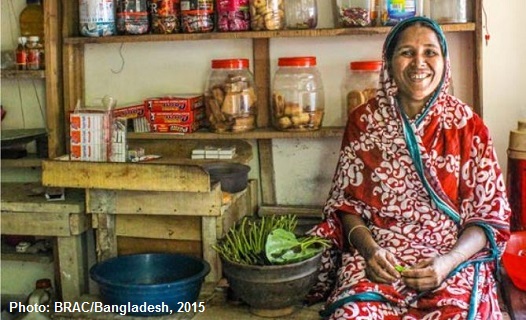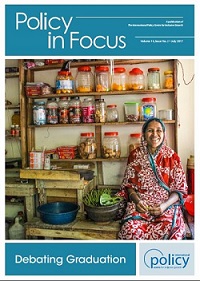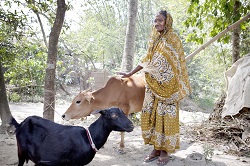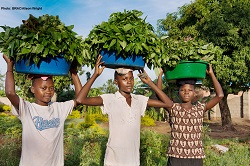New Policy in Focus debates the impact and effectiveness of the Graduation Approach in combating extreme poverty worldwide
By IPC-IG

"Debating Graduation" features specialist guest editors Fabio Veras Soares and Ian Orton and presents 15 inspiring articles that capture the diverse and challenging views comprising the debate surrounding the Graduation Approach
Brasília, 12 July 2017 - The International Policy Centre for Inclusive Growth (IPC-IG) is proud to announce the release of a new issue of its flagship publication, the Policy in Focus magazine, dedicated to the Graduation Approach. This issue, titled ‘Debating Graduation’, features specialist guest editors Fabio Veras Soares and Ian Orton and presents 15 inspiring articles that capture the diverse and challenging views comprising the debate surrounding the Graduation Approach, ranging from committed proponents and enthusiastic new implementers, to the cautiously optimistic, to outright critics of the intervention.

The enthusiasm with and controversy over the Graduation Approach as an effective set of interventions to reduce extreme poverty date back to the beginning of the last decade. In 2002, the Bangladesh-based non-governmental organisation (NGO) BRAC launched a programme titled ‘Challenging the Frontiers of Poverty Reduction-Targeting the Ultra Poor’ (CFPR-TUP), a mix of interventions designed to support the poorest of the poor families in the rural areas of the country .
The objective of the first phase of the CFPR-TUP programme was to assist the most vulnerable families in achieving sustainable livelihoods, through a combination of one-time asset transfers, access to health care, trainings, safety nets and savings promotion, among other elements. Through the programme, households would be able to create a pathway—or ‘graduate’—out of extreme poverty within a specified time frame. This methodology came to be known as the ‘Graduation Approach’.
Since its inception in Bangladesh, there has been a proliferation in the implementation of new graduation-inspired programmes worldwide. However, this enthusiasm and increased visibility have not been free of controversy. Concerns remain regarding targeting efficacy, equity and what happens post-graduation.
In the magazine’s opening article, specialist guest editors Fabio Veras Soares and Ian Orton offer an overview of the Graduation Approach, including some of the main characteristics of phases one and two the CFPR-TUP programme. They also provide an overview of all the contributions in the magazine.
The results of assessments of the second phase of the programme, based on randomised control trials, are presented in two articles: ‘The labour markets of the ultra-poor’, by Clare Balboni et al., and ‘(Accidentally) Harvesting igher hanging fruits: addressing under-5 malnutrition using the Graduation Approach’, by Wameq Raza.

The expansion and adaptation of the Graduation Approach worldwide is the theme of the two opening articles, ‘What does the future hold for graduation?’, by Harshani Dharmadasa et al. and ‘The Graduation Approach within social protection: opportunities for going to scale’, by Aude de Montesquiou and Syed Hashemi. With 57 programmes in almost 40 countries, the Graduation Approach has been adapted to a wide range of contexts, including urban areas. A growing number of programmes are being implemented by governments, rather than by NGOs or donors.
This growing popularity has also attracted dissenting views. In their critical article ‘The effectiveness of the Graduation Approach: what does the evidence tells us?’, Stephen Kidd and Diloá Bailey-Athias delve into the details of many of the impact evaluations of graduation interventions, highlighting the high level of inclusion errors in programmes in some countries. On the other hand, article ‘What we know about graduation impacts and what we need to find out’, by Nathanael Goldberg, analyses the results of the impact evaluations of six pilots aimed at adapting the Graduation Approach outside Bangladesh and finds positive impacts on many development indicators.
Another important aspect of the ongoing debate is the relationship between the Graduation Approach and social protection. In her article ‘Can Graduation Approaches contribute to social protection floors?’, Christina Behrendt argues that the concept of graduation from poverty is often misunderstood as graduation from a specific programme or from social protection altogether. She considers this view problematic, as it assumes that social protection is only for those people living in extreme poverty, or that social protection and income generation and employment are not compatible, which is not the case at all.
In the same vein, in the article ‘Responsible Graduation’, Keetie Roelen et al. state that the basic right to social protection and the Graduation Approach can be reconciled. ‘Responsible graduation’ could focus on endogenous graduation from poverty based on clear welfare improvement as measured by well-defined indicators, rather than by simply completing an exogenously determined programme cycle of two years.

Moving forward, in his article ‘Challenges for addressing child poverty in Malawi through graduation’, Edward Archibald analyses the risks involved in the use of the Graduation Approach as an ‘exit strategy’ from social cash transfer programmes. The author argues that this may lead to unrealistic expectations regarding the potential of beneficiaries to exit poverty permanently.
The relationship between the Graduation Approach and financial inclusion is discussed in the following articles. In ‘Digital inclusion for the ultra-poor: the Graduation Approach’ Tatiana Ricón presents innovative uses of digital solutions for training and e-payments to facilitate financial inclusion and financial literacy. However, such approaches can also raise some concerns, and in the following article ‘Caveat emptor: the Graduation Approach, electronic payments and the potential pitfalls of financial inclusion’, Paulo dos Santos and Ingrid Kvangraven argue that the geographic distance of electronic banks from their borrowers in low-income areas makes them less inclined to engage in lending to new productive enterprises than traditional microfinance institutions.
In this article ‘Resilience and Graduation’, Greg Collins argues about the need to overcome the opposition between investment in social protection and in graduation options, highlighting that the Graduation Approach can provide resilience component to vulnerable families, such as financial inclusion, making them more resilient to shocks.

Another fresh perspective of the Graduation Approach is presented in the article ‘Leaving no one behind: Graduation for Refugees’. Given the unprecedented displacement of entire populations in recent years, Helene Kuhle et al. highlight the work undertaken by the United Nations High Commissioner for Refugees (UNHCR) regarding graduation, aiming to bridge the gap between humanitarian and development policies.
Wrapping up this special edition is the article ‘Private-sector investment capital in graduation: it is time to unlock sustainable financing at scale’, by Shaifali Puri and Anne Hastings. The authors present a new financial model tasked with combating extreme poverty through graduation, based on social and development impact bonds. They explain its relevance to graduation, the contributions it could make towards the eradication of poverty, and how they can fill the funding gap.
* Article by Denise Marinho dos Santos, Communications Officer
Photo credits:
Photo 1 (top): BRAC. Once destitute and homeless, Jorina, a BRAC microfinance client in Bangladesh, after nine years now owns the largest general store in her area, along with a profitable rice business. She lives in a large brick house on her own land, and is a proud member of her community. Her greatest joy is to help and support her two sons and parents as well as other poor villagers;
Photo 2: Cover of the new Policy in Focus magazine titled "Debating Graduation";
Photo 3: Conor Ashleigh/AusAID. Woman received a cow and goat from BRAC through its TUP programme, Kazipara, Bangladesh, 2012 <https://goo.gl/h8u7Wf>;
Photo 4: BRAC/Alison Wright. Girls carrying vegetable on their heads, Tanzania, 2014;
Photo 5: UNHCR/S.Rich. Cenelia, an internally displaced person in Colombia, makes intricate beaded bracelets.